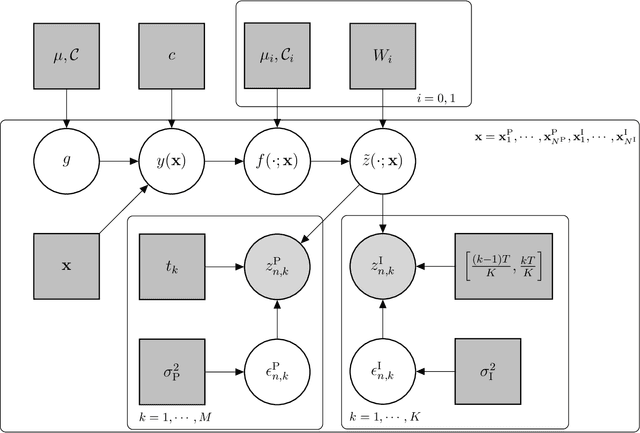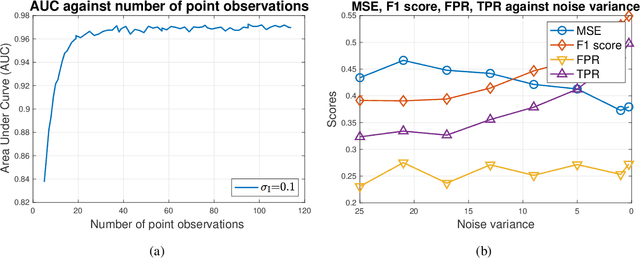Ido Nevat
Binary Spatial Random Field Reconstruction from Non-Gaussian Inhomogeneous Time-series Observations
Apr 07, 2022



Abstract:We develop a new model for binary spatial random field reconstruction of a physical phenomenon which is partially observed via inhomogeneous time-series data. We consider a sensor network deployed over a vast geographical region where sensors observe temporal processes and transmit compressed observations to the Fusion Center (FC). Two types of sensors are considered; one collects point observations at specific time points while the other collects integral observations over time intervals. Subsequently, the FC uses the compressed observations to infer the spatial phenomenon modeled as a binary spatial random field. We show that the resulting posterior predictive distribution is intractable and develop a tractable two-step procedure to perform inference. First, we develop procedures to approximately perform Likelihood Ratio Tests on the time-series data, for both point sensors and integral sensors, in order to compress the temporal observations to a single bit. Second, after the compressed observations are transmitted to the FC, we develop a Spatial Best Linear Unbiased Estimator (S-BLUE) in order for the FC to reconstruct the binary spatial random field at an arbitrary spatial location. Finally, we present a comprehensive study of the performance of the proposed approaches using both synthetic and real-world experiments. A weather dataset from the National Environment Agency (NEA) of Singapore with fields including temperature and relative humidity is used in the real-world experiments to validate the proposed approaches.
Cost-aware Feature Selection for IoT Device Classification
Sep 02, 2020



Abstract:Classification of IoT devices into different types is of paramount importance, from multiple perspectives, including security and privacy aspects. Recent works have explored machine learning techniques for fingerprinting (or classifying) IoT devices, with promising results. However, existing works have assumed that the features used for building the machine learning models are readily available or can be easily extracted from the network traffic; in other words, they do not consider the costs associated with feature extraction. In this work, we take a more realistic approach, and argue that feature extraction has a cost, and the costs are different for different features. We also take a step forward from the current practice of considering the misclassification loss as a binary value, and make a case for different losses based on the misclassification performance. Thereby, and more importantly, we introduce the notion of risk for IoT device classification. We define and formulate the problem of cost-aware IoT device classification. This being a combinatorial optimization problem, we develop a novel algorithm to solve it in a fast and effective way using the Cross-Entropy (CE) based stochastic optimization technique. Using traffic of real devices, we demonstrate the capability of the CE based algorithm in selecting features with minimal risk of misclassification while keeping the cost for feature extraction within a specified limit.
Sensor Selection and Random Field Reconstruction for Robust and Cost-effective Heterogeneous Weather Sensor Networks for the Developing World
Nov 23, 2017

Abstract:We address the two fundamental problems of spatial field reconstruction and sensor selection in heterogeneous sensor networks: (i) how to efficiently perform spatial field reconstruction based on measurements obtained simultaneously from networks with both high and low quality sensors; and (ii) how to perform query based sensor set selection with predictive MSE performance guarantee. For the first problem, we developed a low complexity algorithm based on the spatial best linear unbiased estimator (S-BLUE). Next, building on the S-BLUE, we address the second problem, and develop an efficient algorithm for query based sensor set selection with performance guarantee. Our algorithm is based on the Cross Entropy method which solves the combinatorial optimization problem in an efficient manner.
 Add to Chrome
Add to Chrome Add to Firefox
Add to Firefox Add to Edge
Add to Edge